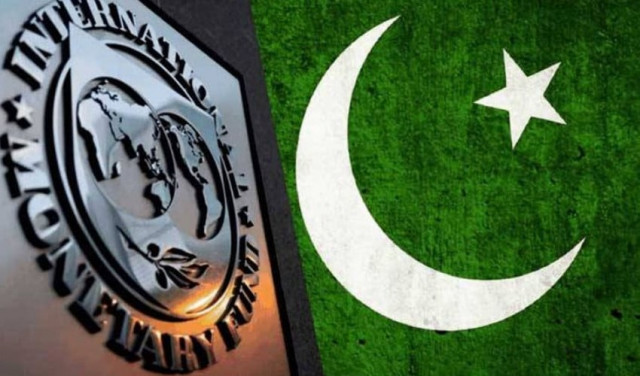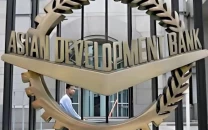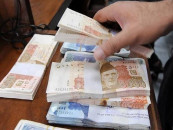Pakistan meets key IMF conditions
Deal stays on track, but Rs394b revenue gap strains budget

The International Monetary Fund's $7 billion bailout package largely remained on track during the first nine months of this fiscal year, as the federal and provincial governments met three out of five major fiscal conditions, with the Federal Board of Revenue (FBR) remaining the only weak link.
The FBR missed its two key conditions of collecting Rs9.17 trillion total revenues and Rs36.7 billion from retailers under the Tajir Dost scheme during July-March period of this fiscal year, showed the fiscal operations summary released by the Ministry of Finance on Wednesday.
The IMF has set multiple fiscal conditions, whose successful completion has so far helped smooth continuation of the programme despite initial setbacks. In spite of achieving critical revenue targets, the federal government's net revenues were still Rs394 billion less than its needs for just two heads; interest payments and defence spending, according to the Finance Ministry.
The fiscal operations' summary showed that Pakistan met the IMF targets for a primary budget surplus by the federal government, as well as net revenue collection and cash surplus targets by the four provinces.
Against a primary surplus target of Rs2.7 trillion, the federal government reported a surplus of Rs3.5 trillion, or 2.8% of gross domestic product (GDP). This higher surplus was primarily due to fully booking the annual central bank profit in the first quarter, with the entire estimated profit of Rs2.5 trillion already accounted for.
The four provinces collectively generated a cash surplus of Rs1.028 trillion, exceeding the IMF target by 25 billion. The federating units also generated Rs685 billion in tax revenues, surpassing the IMF target by Rs79 billion.
The Finance Ministry said that the provincial tax collection "strong performance was primarily driven by the governments of Sindh, Khyber Pakhtunkhwa (K-P), and Balochistan". It did not mention Punjab government in the statement.
The ministry further stated that non-tax revenues of the provinces reached to Rs203 billion, surpassing the target of Rs160 billion by Rs43 billion. This achievement reflects the collective efforts of all provincial governments in enhancing non-tax revenue streams, it added.
The federal government's tax revenue performance was below the mark. The FBR failed to collect any significant revenue under the Tajir Dost Scheme against the target of Rs36.7 billion for nine months. The traders' income tax contribution through withholding taxes too remained negligible compared to salaried class's Rs391 billion payments in nine months.
Moreover, against a nine-month revenue target of over Rs9.2 trillion, the FBR pooled Rs8.5 trillion, falling short of the goal by Rs715 billion.
Thanks to the central bank and millions of people paying petroleum levy, the non-tax revenues amounted to over Rs4 trillion, exceeding the target by Rs71 billion. In just nine months, the petroleum levy collection amounted to Rs834 billion compared to Rs720 billion in the last fiscal year.
Provincial governments enjoy significant fiscal flexibility due to increased revenues under the National Finance Commission (NFC) award. During the July-March period, the four provincial governments spent approximately Rs5.3 trillion, with development spending reaching Rs1.2 trillion. Their total revenues stood at Rs6.1 trillion, of which Rs5.1 trillion came from their shares in the federal taxes.
A breakdown of provincial performance shows that Punjab, with total revenue of Rs2.9 trillion, spent Rs2.4 trillion, generating a surplus of Rs441 billion. However, the province recorded a statistical discrepancy of Rs117 billion, mainly due to below-the-line expenditures to retire wheat debt.
Sindh booked a cash surplus of Rs395 billion after spending Rs1.5 trillion well below its total revenues. The province also reported a Rs10 billion statistical discrepancy.
Khyber-Pakhtunkhwa (K-P) recorded a budget surplus of Rs111 billion, with Rs1.03 trillion in income and Rs920 billion in expenditures. K-P also had a statistical discrepancy of Rs13 billion.
Balochistan generated a surplus of Rs105 billion, meaning the province has more revenue than its needs. The federal government last month increased the petroleum levy rate by Rs8 per litre in the name of funding Balochistan roads.
The Finance Ministry said that provincial development overspending was primarily observed in Punjab and Balochistan, while Sindh and K-P remained within their development expenditure targets.
Pakistan has agreed to approximately 40 conditions under the $7 billion IMF deal. As part of the programme, the four provincial governments must generate a total cash surplus of Rs1.217 trillion in the current fiscal year.
On the expenditure side, the federal government spent a total of Rs11.5 trillion during the first nine months, with current expenditures reaching Rs10.7 trillion. This represented an Rs1.9 trillion or 19% increase in total expenditures compared to the same period last year, primarily due to rising interest payments.
The federal government paid Rs6.4 trillion in interest costs, an increase of Rs921 billion from the previous year. Defence spending amounted to Rs1.42 trillion, higher by 16.5%.
After distributing the provincial share, the federal government's net income stood at Rs7.5 trillion, which was Rs394 billion less than the combined spending on interest and defence. The Finance Ministry said that its primary current expenditures remained well within the targeted ceilings, with actual spending recorded at Rs4.3 trillion against a target of Rs5.2 trillion. The primary reason for this was lower releases of subsidies, which stood at only 49% of the allocated target. The ministry admitted that the development expenditure of Rs309 billion also remained under the spending target of Rs658 billion.




















COMMENTS
Comments are moderated and generally will be posted if they are on-topic and not abusive.
For more information, please see our Comments FAQ